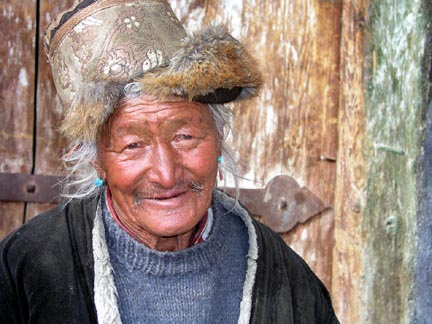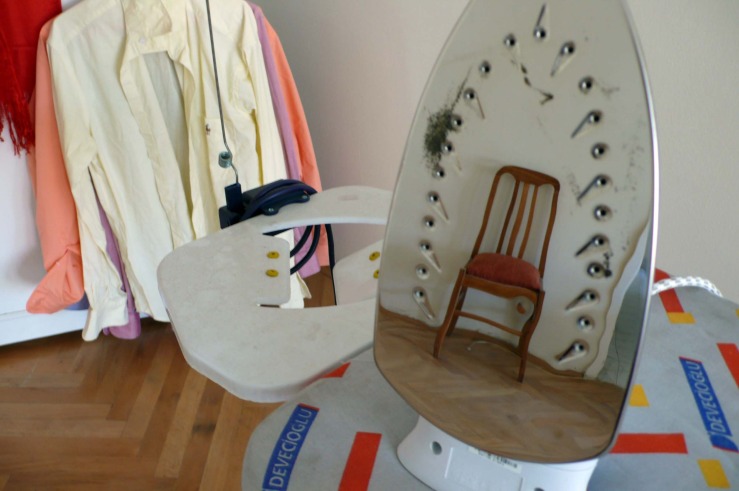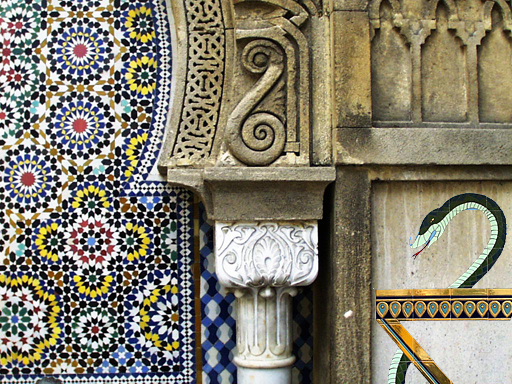Published in A Century is Nothing and Subject to Change.
I visited in 1987 after receiving a single tourist visa for eight days through their embassy in Kuwait and approval from the capital, Thimphu. While there I met a government official who approved an extension allowing me access to Bumthang in the east.
Bhutan, then and now, limits tourist visas to approximately 4,000 a year and focuses on groups. It cost $185 a day.
King Jigme Wangchuck had seen the effect of unregulated tourism in Nepal and realized the importance of protecting the environment, thus the small number of annual visitors. I understand they now have internet and one traffic light in Thimphu.
+
We left Dhaka aboard a fourteen passenger Dornier prop jet plane known for their ability to use short runways in high mountains. We flew over deltas, flooded monsoon farmlands, and small fishing hamlets into Himalayan valleys.
We approached the Paro valley at 7,300 feet, above the Paro Chu River, Tibetan homes, green rice terraces and thick forests covered in low clouds. Our landing was fast.
Guides took us to the Olathang Hotel on a mountain overlooking the Paro valley where the population is 20,000. The hotel is a beautiful building featuring hand painted inlaid spiral art motifs and relief work common to Tibetan paintings.
Lunch was a buffet of red rice, steamed vegetables and canned mutton with dessert. The Bhutan Tourist Corporation hired the World Tourist Organization in France to train 300 employees, including eighteen guides. They covered all areas of tourism operations.
Our group visited the National Museum or Ta-Dzong, a 369-year old ornate structure with inlaid wood, Tibetan interlocking blocks, flowers and hand carved paintings in fantastic detail. This featured a display of Bhutanese culture and history; wall hangings, archery (the national sport), pottery, script, textiles, jewelry, animals, yak butter lamps, and an intricate "Tree of Life." The raven is the national bird.
Bhutanese believe in reincarnation and sects of Buddhist faith. We were told by Kinley, our guide, that lamas or abbots in Bhutan gain knowledge through books and the great lamas can be a reincarnation with magical powers. The lotus tradition came from a lake in India. A great lama was found on a lotus and Buddha said that in the 8th century, according to Bhutanese history, a man more knowledgeable than him would carry on the teachings. Guru Rimpoche was this man and the founder of the Drupa School in Bhutan. He had two reincarnations and is credited with building all the dzongs and monasteries in Bhutan while also conducting battles against Tibet.
Guru Padma Sambhava or Guru Rimpoche (Precious Teacher) was the spiritual founder of the Nyingmapa 'old' school of Himalayan Buddhism in 800 A.D. which is still taught in central Bhutan. Tantric Buddhism in Bhutan dates to 450 A.D. and is the esoteric form of the Drukpa Kayyupa Buddhist School. The state religion of Mahayana Buddhism or the 'Great Vehicle' was established in the 8th century. The Tantric sect of Buddhism found in Central Bhutan have monks called Gomchen. They marry, have children, and unlike the Drupa Sect practised in the western part of the country, the monks have given up all their worldly possessions. The Tantric sect believes in magical spirits and the power of rocks, sky and earth nature.
Below the museum was the Rimpong Dzong built in 1646. Until the 17th century, dzongs were fortresses against attacks both internally and from Tibet. They now serve as state monasteries and district administration headquarters for Bhutan's eighteen districts. They are all elegant and massive architectural structures with a pitched roof, rich woodwork and a distinct pattern. The Rimpong Dzong in Paro has a brightly painted yellow roof and a gold utse or chorten tower. Chortens are quite prevalent on most buildings because they protect against evil spirits in dangerous places. The single entrance is composed of large stone steps and two heavy gigantic wooden doors.
Inside was a large stone courtyard surrounded by walls which house the monks' quarters, kitchens and administrative offices. In some dzongs the courtyards for the monastery and administration of the district are separate. The upper room of the dzong is devoted to religion. A room called a chhoesham is an interior temple with wall paintings, altar, statues and books.
Many children monks with shaven heads, bare feet and burgundy robes greeted us at the Paro Dzong. We removed our shoes and entered a dimly lit room walking on well worn wooden floors. Ceiling high statues of the guru stared down at us as light from yak butter candles flickered and danced around the room.
Prayer wheels turn clockwise to send prayers to heaven dissolving earthly desires.
The next day we visited Tiger's Nest. The shepherd had horses ready and we started off through Blue Pine and Chir Pine in dry locations, rhododendron, fir, spruce and hemlock as the altitude increased from 7,300 feet in the valley to 9,840 feet at the Taktsang Monastery. The green valley supports barley in the winter, maze in the spring and paddy rice, buckwheat and African millet in summer giving way to red clay.
A two hour climb brought us to a rise covered with white prayer flags on weather-beaten brown poles. The valley, Paro Chu River, homes and rice fields stretched out below. We continue on foot, climbing steep trails and reached another prayer flag on a ledge before making a sharp descent down a twisting path and stone steps into a deep gorge. A waterfall crashes from a mountain and small meditation huts were tucked into crevices on the mountain at precarious angles.
According to legend, Rimpoche subdued many demons in Paro and central Bhutan. At one time he had two wives, an Indian and a Tibetan. He transformed his Indian wife into a tiger and flew to establish the Tiger's Nest or Takstang Monastery in the 8th century.
Tiger's Nest is a series of small tight buildings built into the cliff. It is composed of intricate staircases, stone flagging, a small open air kitchen, balconies, rooms for sleeping and meditation. We are welcomed by boys and monks who showed us the meditation room filled with statues, offerings of rice, coins, fruits and vegetables. They showed us the cave where Rimpoche lived for three years. Three monks appointed by the chief abbot in Thimphu live here for three years for meditation study to be followed by novice monks.
We visited the Druk Gyel Dzong (Bhutan Victory) monastery, eighteen miles from the Tibet border. It existed from 1647-1951 before it burned down after a monk fell asleep with an unattended butter lamp.
The drive to the capital Thimphu with a population of 20,000 takes two and a half hours. Glacier activity carved deep valleys north and south.
We stayed at the Molithang Hotel where the lobby has a gigantic brown bear holding an offering of flowers. Hallways are painted with universal symbols; dragons, wheel of life, and each room features intricate detailed artwork.
The Memorial Chorten in Thimphu was built in 1974 by the Queen Mother in memory of her late husband, King Jigme Dorji Wangchuck. It contains three levels of teachings.
1. Phuruba Teaching. Consists of small animals wearing masks when a person dies. We need nine days to take another form and during these nine days we meet all these animals.
2. Kaghav Teaching. Buddha's eight orders. The Eightfold Path or Middle Way exists between self-indulgence and self-modification. The eight orders are: Right Views, Right Purpose, Right Speech, Right Conduct, Right Livelihood, Right Effort, Right Awareness, and Right Concentration or Right Meditation.
3. Gondhu Teaching. The male represents passion, the female represents wisdom. Completion of these three levels of teachings brings the person to Buddhism.
In the evening, we met four Western doctors in the hotel. They've been working in the Thimphu hospital an average of two and a half years. They say the Bhutanese people are slowly accepting Western medicine. If someone is sick they normally visit the lama, then use Bhutanese black medicine, then use Tibetan medicine, normal Bhutanese medicine and finally Western medicine.
The next day I left with Kinley and a driver for Tongza, seven hours and 200 kilometers east.
From Thimphu at 7,800' we climbed to 10,000' and dropped into valleys and climbed again. Various elevations consist of grasslands, croplands, forests, hardwoods, coniferous forests, soft woods, alpine meadows, yak pastures and glaciers. Barley, wheat and potatoes are primary spring and summer crops from 7,500-13,000' with the tree line coming at 12,000-14,000' and coniferous replacing hardwoods above 8,000'.
The Indian Army Corp Engineers are responsible for maintaining the road system in Bhutan. We passed West Bengal, Indian road gangs working at quarter-mile intervals. They perform basic tasks; carrying large rocks away and crushing granite to repair and fill the endless washouts. They live and work here for two-three years maintaining the roads before being replaced by new workers. Their living situation is very grim. Most shelters are woven reeds, fortified with any materials they can find along the rivers. The health conditions are unsanitary. They carry their children on their backs or leave the younger ones under torn umbrellas in the shade.
The Tongza hotel had eleven rooms overlooking a deep valley. The Black Mountain range lies to the north.
The Tongza Dzong, built in 1574, is below a white watchtower. At a school a group of girls say they are interested in business, medicine and teaching. Most Bhutanese students, given the chance, will attend university in India.
The drive to Bumthang crossed a pass at 11,635'. The Wangdi Choling Tourist lodge with twenty-four rooms is empty.
Ten thousand people live in the Bumthang area. Small shops and stores along the single street serve as homes and business. Built of wood with small steel stoves and chimneys, the rooms are multi-purpose; selling in front, eating and sleeping quarters in the rear.
Merchandise includes thread, wool, fabric (as the home weaving supplements income), canned goods, small toys, sweets, local spirits, spices, eggs, limited supply of green vegetables, a few green apples and soap.
The architecture is Tibetan, buildings are rectangular and 2-3 stories high. The pitched roof allows for open space to store firewood and fodder. The middle floor is for storage of grains, seeds and foodstuffs. The upper floor is the living quarters, broken into smaller rooms. The ground floor, on a working farm, is for the cattle. If not, windows are found at this level and there is a shop, storeroom, kitchen and servant's quarters.
We arrived at a monastery where 300-500 Bhutanese have gathered to receive a blessing from a lama. Children and adults sit and talk on rows of timber slabs on the hard sun baked ground.
Three monks blew long wood and silver jallee horns to chase evil spirits away. The lama, Nam Kha Nen Boo, is Khenbow, a reincarnation of a former monk known for his fortune telling power. He was seated and read in a low tone of voice for twenty minutes and using a small hand held drum and bell. Finishing, he moved among the people touching them on the head with a statue called a Tshtshto. This dignifies the life of a human by saying "have a long life."
People approached to bring offerings for his blessing. Bags of red string, flour and jenlap, a nutmeg-like substance, were offered. One lama handed each person jenlap. Another lama gave each person a single red string to be worn around the neck.
We visited the Jakar Dzong. The head lama opened large doors in the quiet spiritual center. Ornate sculptures of Padma Sambhava and yak butter lamps filled the center wall. Inside another room was a fantastic display of the guru, bronze statues with salt and butter flower carvings about 10' high.
Long display cases with hundreds of identical 5-6" Buddha statues sat in tiered arrangement. Larger images depict historical and religious levels of spiritual attainment.
Our nine hour drive to Thimphu took us through valleys, past people working in green and golden fields, up mountains, past grain, road workers, waterfalls, rain, clouds, birds, hot sun, cattle, pack horses, down mountains, hairpin turns, and along rocky roads barely wide enough for a single vehicle.
We moved through sharp steep elevations offering panoramas, rice paddies, shacks, new homes, dzongs, trekkers, water carriers, rock breakers, babies on backs, wicker baskets full of green ferns, wide-eyed children and prayer flags flying in the Land of the Thunder Dragon.
Peace.








 Share Article
Share Article 
